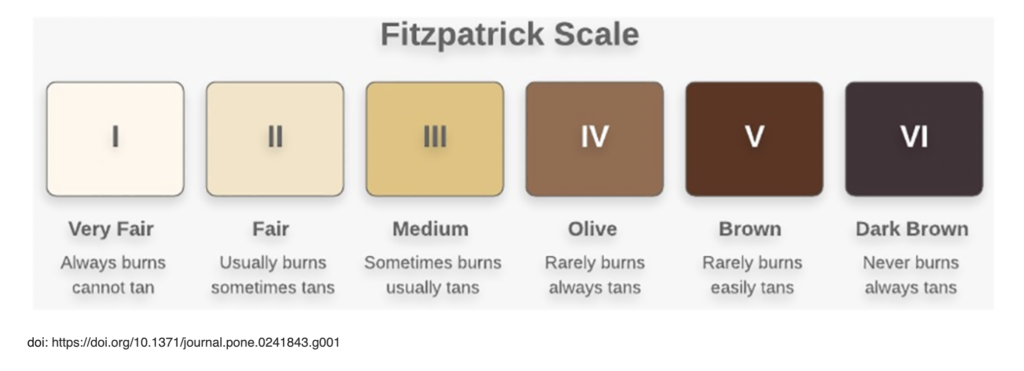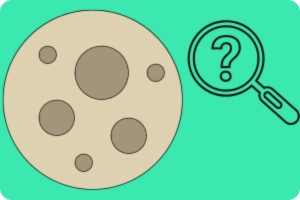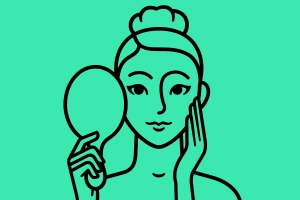There are 2 types of pigmentation:
The portion could be a large, small, or just a spot.
1. Causes for Hyperpigmentation
The main cause of hyperpigmentation is inflammation.
Let me explain how it works.
The skin has two layers: the Epidermis (the top layer) and the Dermis (the bottom layer).
Melanocytes, a few cells between these two layers, produce a pigment called melanin. Melanin gives skin its colour and protects it from the Sun’s harmful UV rays.
Melanocytes produce melanin, which is then distributed to keratinocytes. Once it reaches keratinocytes, the most abundant cells in our skin, melanin performs colour and protective functions.
When skin is inflamed, melanocytes respond by producing more melanin to protect the skin.
So far, so good, right? Yes, but things can get a bit tricky now…Here is how…
Inflammation can cause melanocytes to overproduce melanin, leading to excess melanin production.
This overproduction is common in people with darker skin tones because they are more capable of producing melanin.
One quick note: Excess melanin produced by this overproduction does not mean higher protection. Beyond a certain level, additional melanin does not offer any protection.
On the other hand, fair-skinned individuals produce less melanin, which may not be sufficient to protect their skin.
All the melanin produced by melanocytes is transferred to keratinocytes.
Since darker-skin-toned people can produce excess melanin, some of the melanin is transferred to keratinocyte cells.
Excess melanin results in hyperpigmentation.
Hyperpigmentation means some skin is darker than the rest due to excess melanin. This condition is more common in people with darker skin tones who tend to have higher melanin production.

The Fitzpatrick scale is a widely accepted method of prototyping skin. Phototyping classifies skin based on how it burns and tans.
Skin tans when there is excess melanin in that section of the skin, and skin burns when there isn’t enough melanin to protect it.
Notice how the darker you are, the more tanning you have. The paler you are, the tanning gradually reduces.
I am not saying tanning and hyperpigmentation are the same; I am merely saying that this scale indicates how hyperpigmentation affects skin based on its colour.
The darker you are, the more hyperpigmentation there is. The fairer you are, there is much less, hardly any, or nil hyperpigmentation.
The fairer people have other melanin-related problems, which I will discuss in the hypopigmentation section of this post.
Melanocyte cells will continue producing melanin as long as the skin is inflammed. The darker you are, the more this production becomes excessive.
So, how soon after inflammation occurs should we start using anti-inflammatory skincare products?
The answer is every day—or at least every other day. The skin is always inflammed, thanks to irritants in the environment and the sun’s UV rays. Some of this inflammation is visible, and most are not.
When you feel that your skin has had a rough time or the inflammation is visible, use it more often than you usually would, maybe even multiple times a day.
What do you mean skin having a rough day?
Maybe you got threading done, exfoliated or waxed your skin, was out in the sun a lot that day, or was near a heater the whole day.
The main culprit in hyperpigmentation is inflammation.
Melanocytes are innocent bystanders. They are simply responding to inflammation in the way they know, hyper in some and more subdued in others.
To prevent/reduce hyperpigmentation, we need to be proactive and keep that inflammation down!
Sun’s UV rays:
The sun’s UV rays are harmful. They inflame the skin and can damage good skin cells quickly, further increasing the inflammation.
As soon as they hit the skin, melanocyte cells respond. But melanin, irrespective of how much we have, cannot provide 100% protection.
And so we need to use sunscreen. Reapply it at regular intervals.
One of the main causes of hyperpigmentation is the sun’s UV rays, which we encounter daily.
Anti-inflammatory skin care products are not enough to protect against these rays. We need sunscreen.
If you use all the other amazing products in the world without sunscreen, your skin won’t be happy. If you don’t use any of the amazing products in the world but use sunscreen, your skin will thank you.
Inflammation to the skin from allergens, minor trauma and breakouts:
Let me begin by saying that I am not talking about serious burns, cuts, or skin injuries. These require medical assistance.
I am talking about concerns to skin that are a very common occurrence, like acne, pimples, other breakouts on the skin, attacks from environmental bacteria, allergens, and all other forms of minor trauma.
The inflammation from these is called post-inflammatory hyperpigmentation (PIH).
These need to be attended to and treated with the right products. Anti-inflammatory products must also be used simultaneously. Otherwise, they will continue producing excess melanin, resulting in PIH.
PIH will become very visible once the problem is fixed.
PIH is like a reminder of the trauma that happened in that section of the skin.
The only way to avoid or reduce PIH is to use anti-inflammatory ingredients regularly.
There are other causes of hyperpigmentation like melasma, hormonal imbalance, hereditary conditions, specific medication you are taking, severe trauma to the skin – all these need medical assistance.
2. Hypopigmentation
Hypopigmentation is when the affected portion of your skin becomes paler than the rest.
Hypopigmentation occurs when the melanocyte cells in a portion of the skin are damaged to the extent that they either produce no melanin or insufficient melanin.
This portion of skin could be a large area, a small area or just a dot.
Some of the common causes of hypopigmentation are:
Hypopigmentation and hyperpigmentation often occur for the same reason. In the former type of pigmentation, the affected area doesn’t have enough melanin, while in the latter type, the affected area has more than the required melanin.
Hypopigmentation from the sun’s UV rays is common among fairer skin-toned people. Often, darke15r skin-toned people end up with hyperpigmentation rather than hypopigmentation. That said, hypopigmentation can occur in anyone, regardless of skin colour.
Hypopigmentation in darker skin-toned people is often more visible/apparent than in fairer skin-toned people because of the contrast in colour.
Once it appears, hypopigmentation is very difficult to fix—almost impossible. No off-the-shelf skincare products can help, but a dermatologist might.
Regular use of sunscreen prevents pigmentation (both types) from the sun’s UV rays.
Another common cause of hypopigmentation is acne and other breakouts. Using skincare products to calm the inflammation caused by acne and breakouts reduces the chances of hypopigmentation.


